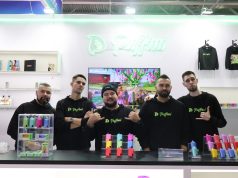The Vaping Post: Now we are in 2017, what do you retain from the year 2016?

Lawrence Berkeley Team: As vaping became more popular and raised its visibility, this past year we have seen that interest in the scientific community continued to grow, leading to an exponential number of studies being published in the literature, special workshops and symposia, etc. Also, funding agencies are assigning more resources to studies on e-cigs, which in turns drives even more attention from scientists. As a consequence, there is now much more information available, and a more complete picture is developing. New scientific information spans from basic technical aspects such as the composition of e-liquids and vapor (our field of research) to behavior, health effects and policy. At the same time vaping technologies and formulation of e-liquids continue to evolve, making some of the early findings partially outdated in a very short time.
Something to retain from 2016 is the decision by the FDA deeming e-cigarettes to be subject to the agency’s regulatory purview. The State of California has also enacted several new tobacco-control laws in 2016, which among other measures regulate e-cigarettes as a conventional tobacco product, raise the legal age for purchasing tobacco to 21 and expand smoke-free workplaces and schools. All these actions are supported by a body of research that, in the case of e-cigarettes, was in most cases produced in the past 3-5 years.
From our own research and other studies we have learned that heating the e-liquid generates volatile aldehydes such as acrolein and formaldehyde, among other compounds, which can be harmful to vapers and to those exposed passively. These chemicals are byproducts of the thermal decomposition of propylene glycol (PG) and glycerin (VG), the two main constituents of most e-liquids. The process by which these compounds are formed depends critically of four factors: the design of the vaporizer, the battery power applied, the composition of the e-liquid and the patterns of use. The first three are potentially subject to regulation, and require effective methods and metrics that are only now being developed. In addition to those decomposition byproducts, other studies have shown that many flavoring compounds present in e-liquid formulations are also mucosal irritants. There is also growing concern about impacts on the cardiovascular system via oxidative stress.
The Vaping Post: What would be your expectations for this year 2017?
Lawrence Berkeley Team: Three issues emerge in the landscape as potentially major changes this year and in the near-term:
- Voters just approved recreational marijuana propositions in California and a few other States, joining Colorado, Washington and Oregon. Vaping devices may increasingly be used to deliver THC and other cannabinoids, and
- The release of a new generation of heat-not-burn devices that may compete with current e-cigs for similar segments of consumers
- In California, a $2 tax increase on all tobacco products may contribute to lowering the prevalence of smoking and boost funding for future tobacco control and research.
The Vaping Post: What are your main concerns going forward?
Lawrence Berkeley Team: One of our main concerns is the impacts on adolescents and young users. This is a particularly susceptible population which is usually targeted by e-cigarette and tobacco advertising, and is prone to engage in more risky behaviors. The health effects associated with extreme vaping such as “cloud chasing” and “sub-ohming” have not been sufficiently studied. Despite the proliferation of websites and blogs addressing this audience, there are very little resources available online with serious information about risks.
The Vaping Post: What did you learn from your international perspective on vaping?
Lawrence Berkeley Team: If we look beyond the US, it is interesting to see how public health authorities in different countries adopt completely different policies: from directly encouraging the use of e-cigs by current smokers in the UK, to outright banning their commercialization in several countries (e.g., Argentina).

In Europe, the EU Tobacco Products Directive (2014/40/EU) regulating e-cigarettes and other nicotine vapor products entered in force in May 2016. The new regulation aims to improve safety and quality requirements for e-cigarettes and to protect the public’s health. Some of the new rules include: maximum nicotine concentrations (20 mg/mL) and maximum volumes for cartridges (2 mL), tanks and nicotine liquid containers (10 mL), child proof packaging, prohibition of e-cigarettes promotion and cross-border advertising as well as mandatory health warnings and listing of all ingredients on packaging. All these different measures reflect the diversity of issues and concerns raised by public health advocates.
In Argentina, a 2011 resolution from the National Administration of Medications, Food and Medical Technology (ANMAT) and the National Law N° 26.687 prohibit importing, distributing, marketing and advertising of e-cigarettes. This decision was recently ratified in December 2016 by the ANMAT, concluding that there is no evidence that e-cigarettes present a better alternative to quit smoking than traditional cessation products. As a consequence, availability of e-cigarettes through informal commercial routes is limited, and prices relatively high.
The principal correspondent for this interview is Dr Hugo Destaillats, PhD, Staff Scientist at Lawrence Berkeley National Laboratory (USA). The content of the interview has been discussed and reflects a consensus of the research team:
- Dr Lara Gundel, PhD, Staff Scientist at Lawrence Berkeley National Laboratory, USA;
- Dr Mohamad Sleiman, PhD, Assistant Professor, Sigma Clermont University, France;
- Dr Nahuel Montesinos, PhD, Scientist at Comisión Nacional de Energía Atómica & CONICET, Argentina.
More readings about Mohamad, Lara, Nahuel and Hugo’s work:
Image credit: LBNL & N. Montesinos








